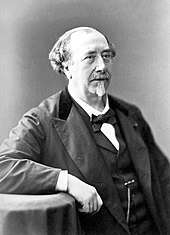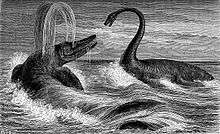Louis Figuier
Louis Figuier (15 February 1819 – 8 November 1894) was a French scientist and writer. He was the nephew of Pierre-Oscar Figuier and became Professor of chemistry at L'Ecole de pharmacie of Montpellier. Though his works are highly respected, it is often unmentioned that he was in fact a staunch racist of the time (see The Human Race). Figuier played a key role in perpetuating the blatantly myopic misconception that people of black origin were mentally inferior, were not fully human, smelled poorly, and were promiscuous. His citing of these ill-formed concepts of course were and are not true yet he remains celebrated in his achievements.


Career
Figuier became Doctor of Medicine (1841), agrégé of pharmacology, chemistry (1844–1853) and physics and gained his PhD in (1850). Figuier was appointed professor at L'Ecole de Pharmacie of Paris after leaving Montpellier. In his research he found himself opposed to Claude Bernard; as a result of this conflict, he abandoned his research to devote himself to popular science. He edited and published a yearbook from 1857 to 1894 – L'Année scientifique et industrielle (or Exposé annuel des travaux) – in which he compiled an inventory of the scientific discoveries of the year (it was continued after his death until 1914). He was the author of numerous successful works: Les Grandes inventions anciennes et modernes (1861), Le Savant du foyer (1862), La Terre avant le déluge (1863) illustrated by Édouard Riou, La Terre et les mers (1864), Les Merveilles de la science (1867–1891).
Influenced by Charles Lyell's Geological Evidences of the Antiquity of Man of 1863, the 1867 second edition of La Terre avant le déluge abandoned the Garden of Eden shown in the first edition, and included dramatic illustrations of savage men and women wearing animal skins and wielding stone axes.[1]
Main works

- La terre avant le deluge, 1863, 2nd. edition 1867
- English translation, World Before the Deluge,[2] 1872
- Swedish translation by Carl Hartman, Jorden före syndafloden, 1868, based on the 5th French edition
- The Vegetable World, 1867
- The Ocean World, 1868
- The Insect World, 1868
- Reptiles and Birds, 1869
- Primitive Man, 1871
- The human race, 1872[3][4]
- Les Merveilles De La Science, Ou Description Populaire Des Inventions Modernes, (The wonders of science or a popular description of modern inventions), 1891
Footnotes
- Browne 2002, pp. 218, 515.
- "Before the Flood". geology.19thcenturyscience.org.
- "The human race". Internet Archive.
- "The Project Gutenberg eBook of The Human Race, by Louis Figuier". gutenberg.org.
References
| Wikisource has original works written by or about: Louis Figuier |
| Wikimedia Commons has media related to Louis Figuier. |
- Browne, E. Janet (2002), Charles Darwin: vol. 2 The Power of Place, London: Jonathan Cape, ISBN 0-7126-6837-3
External links
- Works by Louis Figuier at Project Gutenberg
- Works by or about Louis Figuier at Internet Archive
- Figuier's Merveilles de la science (6 vols., 1867-1891) - digital facsimiles from Linda Hall Library
- A selection of high-resolution scans from Figuier's L'homme primitif, Primitive man, and Terre avant deluge - from Linda Hall Library